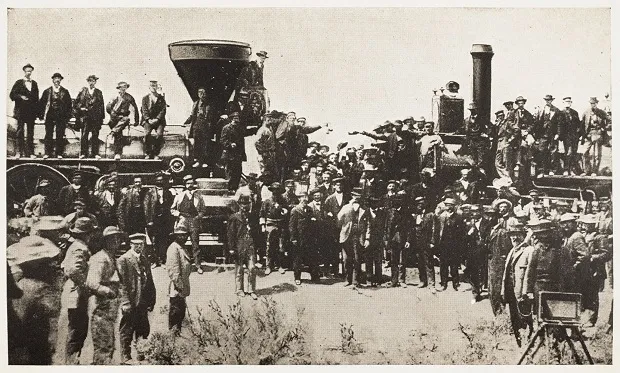In a historic moment in 1869 at Promontory, Utah, the presidents of the Union Pacific and Central Pacific Railroads met to drive the final, golden spike. This event not only marked the completion of the first transcontinental railroad in the United States but also ushered in a new era for travel, commerce, and the development of the Wild West. This connection significantly shortened travel times, transforming arduous journeys by stagecoach into comfortable train rides.
The Plan to Connect Two Coasts
As early as 1832, political leaders recognized the necessity of connecting the East and West Coasts of the United States by rail. However, it wasn’t until 1853 that Congress approved funding for surveying potential transcontinental railroad routes. This ambitious project was delayed due to political tensions between the North and South, making it difficult to agree on a starting point for the line.
The Pacific Railroad Act and the Beginning
Following the American Civil War, Congress, under Republican control, passed the Pacific Railroad Act of 1862. This act provided generous land grants and loans to two chosen railroad companies to build the transcontinental line: Union Pacific and Central Pacific. In 1866, the two companies began constructing the railway from Omaha, Nebraska, and Sacramento, California, aiming to create a northern route that would unite the nation.

Driven by the desire to claim more land, both routes were built without parallelism, necessitating negotiations to determine the final meeting point. This competition, though economically motivated, spurred rapid construction progress.
Formidable Challenges
Union Pacific workers, predominantly Irish veterans from the Civil War, faced immense hardships, including harsh winters, scorching summer heat, attacks by Native Americans, and lawlessness in newly established frontier towns. Central Pacific, with a workforce mainly of Chinese immigrants, also faced its own set of challenges, including grueling 12-hour workdays to lay tracks through the Sierra Nevada mountains.
Numerous tragic accidents occurred, including avalanches that buried entire crews and deadly explosions. These harsh working conditions placed enormous demands on the endurance and spirit of those involved in building the historic railway.
Completion Ahead of Schedule and Profound Impact
Despite the difficulties, the workers of both companies completed the railway – nearly 2,000 miles of track – in 1869, ahead of schedule and within budget. The railway dramatically reduced travel time, from months by stagecoach or weeks by ship to just days.
:strip_icc():format(webp)/transcontinental-railroad-map-2360271v3-5b40654bc9e77c0037360357.jpg)
The impact of the railroad was immediate and profound. The years following its construction witnessed rapid growth and expansion of the United States, largely due to the speed and convenience of rail travel. It boosted trade, facilitated westward migration, and connected communities across the nation.
Utah’s Railroad History: More Than Just a Route
The history of railroads in Utah is not merely a tale of engineering and construction, but also one of human perseverance, innovation, and the aspiration for connection. These railways transformed the American landscape, unlocking new opportunities and reshaping the nation’s future. Today, the legacy of these railroads endures, reminding us of the power of collaboration and the importance of connectivity.
Conclusion
The history of railroads in Utah is a pivotal chapter in American history. It is not just a story about building a railway, but a story about connection, progress, and transformation. These railroads contributed immensely to the development of the United States and continue to be a vital part of the national heritage.